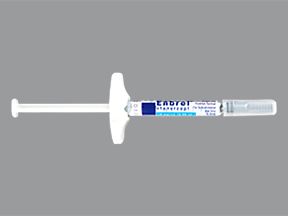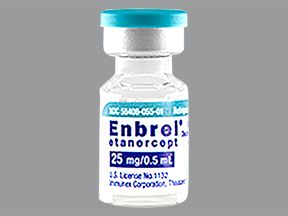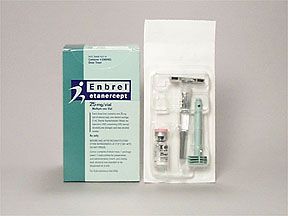If you have certain inflammatory conditions, your doctor might suggest Enbrel (etanercept) as a treatment option for you.
Enbrel is a prescription medication that’s used to treat the following conditions:
- psoriatic arthritis in adults
- rheumatoid arthritis in adults
- ankylosing spondylitis in adults
- polyarticular juvenile idiopathic arthritis in children
- plaque psoriasis in adults and children
This article describes the dosages of Enbrel, including its forms, strengths, and how to take the drug. To learn more about Enbrel, see this in-depth article.
Note: This article covers Enbrel’s typical dosages, which are provided by the drug’s manufacturer. But when using Enbrel, always take the dosage that your doctor prescribes.
Enbrel is a medication that’s given by subcutaneous injection (an injection under your skin). The drug comes in several forms and strengths.
When you first start Enbrel, you may receive Enbrel injections at your doctor’s office. Then they’ll show you how to give yourself injections at home. You can also ask your pharmacist to show you how to use Enbrel.
What are the forms of Enbrel?
Enbrel is available in the following forms:
- liquid solution inside single-dose prefilled syringes*
- liquid solution inside prefilled SureClick auto-injectors*
- liquid solution inside Enbrel Mini single-dose prefilled cartridges* (used with AutoTouch auto-injectors)
- liquid solution inside single-dose vials (given as an injection using a syringe)
- powder inside multidose vials (which is mixed into a solution before being injected with a syringe)
* This form of the drug contains dry natural rubber. If you have a latex allergy, let your doctor know before using Enbrel.
What strengths does Enbrel come in?
The available strengths of Enbrel vary depending on the form of the drug you use.
Single-dose prefilled syringes:
- 25 milligrams (mg) per 0.5 milliliters (mL) of solution
- 50 mg per 1 mL of solution
SureClick auto-injector:
- 50 mg per 1 mL of solution
Enbrel Mini single-dose prefilled cartridge:
- 50 mg per 1 mL of solution (used with the AutoTouch reusable auto-injector)
Single-dose vial of solution:
- 25 mg per 0.5 mL of solution
Multidose vial of powder:
- 25 mg of powder, which is mixed with 1 mL of sterile water
Note: The Enbrel multidose powder is used for dosage strengths other than 25 mg or 50 mg. For example, children who are on weight-based doses may need additional dosage options.
What are the typical dosages of Enbrel?
Your dose of Enbrel will depend on the condition it’s being used to treat and other factors. These may include your age, weight, and any other health conditions you have.
You may start treatment with a certain dose that your doctor adjusts over time until you reach the right amount for you. Your doctor will ultimately prescribe the smallest dose that provides the desired effect.
The information below describes dosages that are commonly used or recommended. However, be sure to take the dosage your doctor prescribes for you. Your doctor will determine the best dosage to fit your needs.
Dosage for rheumatoid arthritis
The Enbrel dosage for treating rheumatoid arthritis (RA) in adults is typically 50 mg injected once weekly. Some people with RA may be prescribed methotrexate with Enbrel. Your doctor will determine whether you should use methotrexate. They’ll also show you how to give yourself the Enbrel injection.
Dosage for psoriatic arthritis
The typical Enbrel dosage for adults with psoriatic arthritis is 50 mg given once weekly. Depending on your symptoms, your doctor may prescribe methotrexate with Enbrel.
Your doctor will determine whether you should use methotrexate. They’ll also show you how to give yourself the Enbrel injection.
Dosage for plaque psoriasis
For adults with plaque psoriasis, the typical starting dosage (also called a loading dose) of Enbrel is 50 mg given twice a week for 3 months. Your doctor will start you at this higher dose to help your body respond faster to treatment.
After 3 months, your doctor will lower your dose to 50 mg given once per week.
For information on children’s dosages for plaque psoriasis, see the “What’s the dosage of Enbrel for children?” section below.
In some cases, your doctor may start you on a lower 25-mg or 50-mg dose given once per week, instead of a twice-weekly starting dose. This will depend on your condition and other health factors.
Your doctor will determine the best dosage for you and will make any necessary adjustments over time.
Dosage for ankylosing spondylitis
The typical starting dose of Enbrel for ankylosing spondylitis is 50 mg injected once weekly.
For this condition, your doctor may prescribe other medications, such as methotrexate, for use with Enbrel.
Dosage for polyarticular juvenile idiopathic arthritis
Enbrel can be used in children ages 2 to 17 years with polyarticular juvenile idiopathic arthritis (JIA). The dosage is based on weight:
- For children who weigh 138 pounds (lb)* or more, the typical dosage is 50 mg given once per week.
- For children who weigh less than 138 lb,* the dose is 0.8 mg per kg given once per week. Your child’s doctor or a pharmacist will calculate the correct dose.
Note: If a child’s weight changes over time, their doctor will need to adjust their dose again.
* 138 lb equals 63 kilograms (kg).
What’s the dosage of Enbrel for children?
For the dosage used in children with polyarticular JIA, see the section above.
Enbrel can be used in children ages 4 to 17 years with plaque psoriasis. The dosage is based on weight:
- For children who weigh 138 lb* or more, the typical dosage is 50 mg given once per week.
- For children who weigh less than 138 lb* the typical dosage is 0.8 mg per kg of body weight given once per week. Your child’s doctor or a pharmacist will calculate the correct dose.
* 138 lb equals 63 kilograms (kg).
Is Enbrel used long term?
Yes, Enbrel is typically used as a long-term treatment. If you and your doctor determine that Enbrel is safe and effective for you, it’s likely that you’ll use it long term.
Dosage adjustments
In some cases, your doctor may need to adjust your dosage of Enbrel depending on your condition, weight, and how you respond to treatment.
For example, the dosage of Enbrel used in children is based on weight.
Keep in mind that it may take a few weeks or longer to see an improvement in your symptoms. Talk with your doctor if you have questions about whether Enbrel is working for you.
The dosage of Enbrel you’re prescribed may depend on several factors. These include:
- the type and severity of the condition you’re using Enbrel to treat
- your age and weight
- the form of Enbrel you use
To avoid side effects from Enbrel, your doctor will prescribe the smallest dose that’s effective for your condition. If you have questions about what your dosage should be, talk with your doctor or pharmacist.
Enbrel is a medication that’s given by subcutaneous injection (an injection under your skin). The drug comes in several forms and strengths.
Enbrel is used to treat these conditions:
- psoriatic arthritis in adults
- rheumatoid arthritis in adults
- ankylosing spondylitis in adults
- polyarticular juvenile idiopathic arthritis in children
- plaque psoriasis in adults and children
To learn more about Enbrel’s uses, see this in-depth article on the drug.
If you miss a dose of Enbrel, take it as soon as you remember. However, if it’s almost time for your next dose, just skip the missed dose and give yourself your next injection at its regular time. You shouldn’t give yourself two injections at once to make up for a missed dose. This can raise your risk for serious side effects.
To help make sure you don’t miss a dose, try using a medication reminder. This can include setting an alarm, downloading a reminder app, or setting a timer on your phone. A kitchen timer can work, too.
Don’t use more Enbrel than your doctor prescribes. Using more than this can lead to serious side effects.
What to do in case you use too much Enbrel
Call your doctor right away if you think you’ve used too much Enbrel. You can also call 800-222-1222 to reach the American Association of Poison Control Centers, or use their online resource. However, if you have severe symptoms, call 911 (or your local emergency number) immediately or go to the nearest emergency room.
The sections above describe the typical dosages provided by the drug manufacturer. If your doctor prescribes Enbrel for you, they’ll determine the dosage that’s right for you.
Remember, you shouldn’t change your dosage of Enbrel unless your doctor recommends it. You should use Enbrel exactly as prescribed. Talk with your doctor if you have questions or concerns about your current dosage.
Here are some examples of questions you may want to ask your doctor:
- Will my Enbrel dosage need to be changed if I have kidney disease?
- Will my dosage be adjusted if my symptoms don’t improve?
- Is there a certain form of Enbrel that will work better for my condition?
You can sign up to receive our psoriasis or rheumatoid arthritis newsletters if you use Enbrel to treat either of these conditions.
Q:
If my child weighs less than 138 pounds (lb), will they need to use a specific form of Enbrel?
Anonymous patientA:
Yes. Typically, children who weigh less than 138 lb, which equals 63 kilograms (kg), will be prescribed the Enbrel multidose vial of powder.
The Enbrel dose for children who weigh less than 138 lb (63 kg) is based on body weight. And the powder form of Enbrel can be used to create multiple dosage options.
The other forms of Enbrel are only available in strengths of 25 milligrams (mg) or 50 mg. Therefore, they may not provide the dose your child needs based on their weight.
Your child’s doctor or a pharmacist will calculate the correct dose of Enbrel for your child. Your child’s dose may also need to be adjusted if their weight changes.
If you have questions about the form or dosage of Enbrel that’s right for your child, talk with their doctor.
Alex Brewer, PharmD, MBAAnswers represent the opinions of our medical experts. All content is strictly informational and should not be considered medical advice.Disclaimer: Healthline has made every effort to make certain that all information is factually correct, comprehensive, and up to date. However, this article should not be used as a substitute for the knowledge and expertise of a licensed healthcare professional. You should always consult your doctor or another healthcare professional before taking any medication. The drug information contained herein is subject to change and is not intended to cover all possible uses, directions, precautions, warnings, drug interactions, allergic reactions, or adverse effects. The absence of warnings or other information for a given drug does not indicate that the drug or drug combination is safe, effective, or appropriate for all patients or all specific uses.



